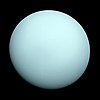Cordelia (moon)
 Cordelia (image taken 21 January 1986) | |
| Discovery | |
|---|---|
| Discovered by | Richard J. Terrile / Voyager 2 |
| Discovery date | January 20, 1986 |
| Designations | |
Designation | Uranus VI |
| Pronunciation | /kɔːrˈdiːliə/[1] |
| Adjectives | Cordelian[2] |
| Orbital characteristics | |
Mean orbit radius | 49751.722 ± 0.149 km[3] |
| Eccentricity | 0.00026 ± 0.000096[3] |
| 0.33503384 ± 0.00000058 d[3] | |
| Inclination | 0.08479 ± 0.031° (to Uranus' equator)[3] |
| Satellite of | Uranus |
| Group | ring shepherd |
| Physical characteristics | |
| Dimensions | 50 × 36 × 36 km[4] |
Mean radius | 20.1 ± 3 km[4][5][6] |
Surface area | ~5500 km2[a] |
| Volume | ~38,900 km3[a] |
| Mass | ~4.4×1016 kg[a] |
Mean density | ~1.3 g/cm3 (assumed)[5] |
| ~0.0073 m/s2[a] | |
| ~0.017 km/s[a] | |
| synchronous[4] | |
| zero[4] | |
| Albedo | |
| Temperature | ~64 K[a] |
Cordelia is the innermost known moon of Uranus. It was discovered from the images taken by Voyager 2 on January 20, 1986, and was given the temporary designation S/1986 U 7.[8] It was not detected again until the Hubble Space Telescope observed it in 1997.[7][9] Cordelia takes its name from the youngest daughter of Lear in William Shakespeare's King Lear. It is also designated Uranus VI.[10]
Other than its orbit,[3] radius of 20 km[4] and geometric albedo of 0.08[7] virtually nothing is known about it. In the Voyager 2 images Cordelia appears as an elongated object with its major axis pointing towards Uranus. The ratio of axes of Cordelia's prolate spheroid is 0.7 ± 0.2.[4]
Cordelia acts as the inner shepherd satellite for Uranus' ε ring.[11] Cordelia's orbit is within Uranus' synchronous orbit radius, and is therefore slowly decaying due to tidal deceleration.[4]
Cordelia is very close to a 5:3 orbital resonance with Rosalind.[12]
See also[]
References[]
Explanatory notes
Citations
- ^ Benjamin Smith (1903) The Century Dictionary and Cyclopedia
- ^ Jennifer Bates (2010) Hegel and Shakespeare on Moral Imagination, p. 102
- ^ a b c d e Jacobson, R. A. (1998). "The Orbits of the Inner Uranian Satellites From Hubble Space Telescope and Voyager 2 Observations". The Astronomical Journal. 115 (3): 1195–1199. Bibcode:1998AJ....115.1195J. doi:10.1086/300263.
- ^ a b c d e f g Karkoschka, Erich (2001). "Voyager's Eleventh Discovery of a Satellite of Uranus and Photometry and the First Size Measurements of Nine Satellites". Icarus. 151 (1): 69–77. Bibcode:2001Icar..151...69K. doi:10.1006/icar.2001.6597.
- ^ a b c "Planetary Satellite Physical Parameters". JPL (Solar System Dynamics). 24 October 2008. Retrieved 12 December 2008.
- ^ a b Williams, Dr. David R. (23 November 2007). "Uranian Satellite Fact Sheet". NASA (National Space Science Data Center). Retrieved 12 December 2008.
- ^ a b c Karkoschka, Erich (2001). "Comprehensive Photometry of the Rings and 16 Satellites of Uranus with the Hubble Space Telescope". Icarus. 151 (1): 51–68. Bibcode:2001Icar..151...51K. doi:10.1006/icar.2001.6596.
- ^ Smith, B. A. (1986-01-27). "Satellites and Rings of Uranus". IAU Circular. 4168. Retrieved 2011-10-31.
- ^ Showalter, M. R.; Lissauer, J. J. (2003-09-03). "Satellites of Uranus". IAU Circular. 8194. Retrieved 2011-10-31.
- ^ "Planet and Satellite Names and Discoverers". Gazetteer of Planetary Nomenclature. USGS Astrogeology. July 21, 2006. Retrieved 6 August 2006.
- ^ Esposito, L. W. (2002). "Planetary rings". Reports on Progress in Physics. 65 (12): 1741–1783. Bibcode:2002RPPh...65.1741E. doi:10.1088/0034-4885/65/12/201.
- ^ Murray, Carl D.; Thompson, Robert P. (1990-12-06). "Orbits of shepherd satellites deduced from the structure of the rings of Uranus". Nature. 348 (6301): 499–502. Bibcode:1990Natur.348..499M. doi:10.1038/348499a0. ISSN 0028-0836. S2CID 4320268.
External links[]
- Moons of Uranus
- Astronomical objects discovered in 1986


